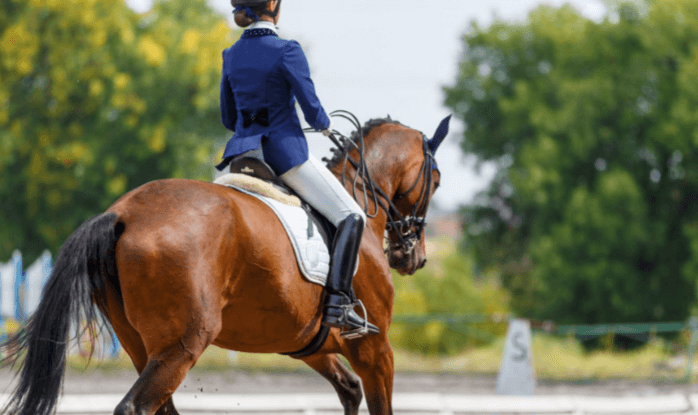What are flying changes, and how can a rider learn to perform them?

Flying changes are a fundamental and elegant component of advanced dressage, requiring precise timing, coordination, and understanding between horse and rider. In this comprehensive guide, we’ll explore what flying changes are, why they are essential in dressage, and how riders can learn to perform them effectively.
What are Flying Changes?
Flying changes, also known as flying lead changes, are a movement in which a horse switches leads at the canter without breaking into a trot or walk. This move is crucial in dressage and show jumping, demonstrating a horse’s balance, responsiveness, and agility. The lead change occurs when the horse changes the leading leg in the canter stride, resulting in a smooth and seamless transition.
The Importance of Flying Changes in Dressage
Flying changes are not just a test of the horse’s abilities but also a measure of the rider’s skill and partnership with the horse. They are included in advanced dressage tests and are essential for high-level competition. Performing flying changes accurately can significantly enhance the overall score in a dressage test, reflecting the horse’s training and the rider’s command.
Learning to Perform Flying Changes: A Step-by-Step Guide
1. Understanding the Basics of Canter Leads
Before attempting flying changes, it’s vital to understand canter leads. In a canter, the horse leads with one front leg, which determines the direction of the canter. A correct lead is essential for balance and fluid movement. Riders must be proficient in recognizing and achieving the correct lead before progressing to flying changes.
2. Developing the Canter Transition
A solid canter transition is the foundation of successful flying changes. Practice transitioning from trot to canter and back, ensuring the horse responds promptly and maintains balance. This practice helps establish a rhythm and enhances the horse’s responsiveness to the rider’s aids.
3. Mastering the Counter-Canter
The counter-canter, where the horse leads with the outside leg while traveling on a curved line, is a crucial exercise for preparing for flying changes. It improves the horse’s balance and flexibility, essential for a seamless lead change.
4. Using Ground Poles for Practice
Incorporating ground poles in training sessions can help horses and riders practice the timing and coordination needed for flying changes. Place poles in a straight line and practice cantering over them, gradually introducing the concept of changing leads over the poles.
5. Working on Lateral Movements
Lateral movements, such as leg-yielding and shoulder-in, enhance the horse’s suppleness and responsiveness to the rider’s aids. These exercises also help the rider develop better control and precision in signaling the horse for a lead change.
6. Introducing Simple Changes
Simple changes, where the horse transitions from canter to trot and back to canter on the opposite lead, are a precursor to flying changes. Practice these transitions smoothly to build the horse’s confidence and understanding of the change in leads.
7. Timing and Coordination
Timing and coordination between the rider’s aids and the horse’s movement are critical for successful flying changes. The rider must signal the lead change precisely as the horse’s leading leg is about to touch the ground, ensuring a fluid and balanced transition.
8. Gradual Introduction of Flying Changes
Introduce flying changes gradually, starting with one change on a straight line. Reward the horse for each successful change and build up to multiple changes as the horse becomes more comfortable and confident.
9. Practicing on a Figure Eight Pattern
Using a figure-eight pattern is an effective way to practice flying changes. This pattern naturally encourages the horse to change leads due to the change in direction, helping to reinforce the concept.
10. Consistency and Patience
Consistency and patience are key in training flying changes. Regular practice, positive reinforcement, and gradual progression help build the horse’s confidence and skill. Avoid rushing the process, as this can lead to confusion and resistance.
Common Challenges and Solutions in Flying Changes
1. Horse Anticipating the Change
Some horses may anticipate the change and become tense. To address this, vary the routine and mix in other exercises to keep the horse focused and responsive.
2. Unbalanced Changes
If the horse changes leads unbalanced or late, work on strengthening the canter transitions and lateral movements to improve balance and coordination.
3. Rider’s Position and Timing
Incorrect rider position or timing can disrupt the flying change. Ensure the rider maintains a balanced seat and gives clear, timely aids for the lead change.
FAQs
What are flying changes? Flying changes are a movement in which a horse switches leads at the canter without breaking into a trot or walk, essential for advanced dressage and show jumping.
How can a rider learn to perform flying changes? Riders can learn flying changes through understanding canter leads, developing canter transitions, mastering counter-canter, using ground poles, working on lateral movements, introducing simple changes, and practicing timing and coordination.
Why are flying changes important in dressage? Flying changes demonstrate a horse’s balance, responsiveness, and agility, significantly impacting dressage test scores and showcasing advanced training and rider skill.
What exercises help in preparing for flying changes? Exercises like counter-canter, lateral movements, simple changes, and using ground poles are crucial for preparing the horse and rider for flying changes.
What are common challenges in performing flying changes? Common challenges include the horse anticipating the change, unbalanced changes, and incorrect rider position and timing.
How can these challenges be addressed? Challenges can be addressed by varying routines, improving canter transitions, focusing on balance and coordination, and ensuring the rider maintains a balanced seat and gives clear aids.
Conclusion
Mastering flying changes is a rewarding journey that enhances the partnership between horse and rider. With patience, consistent practice, and a solid understanding of the fundamentals, riders can achieve smooth, balanced flying changes that elevate their performance in dressage.





